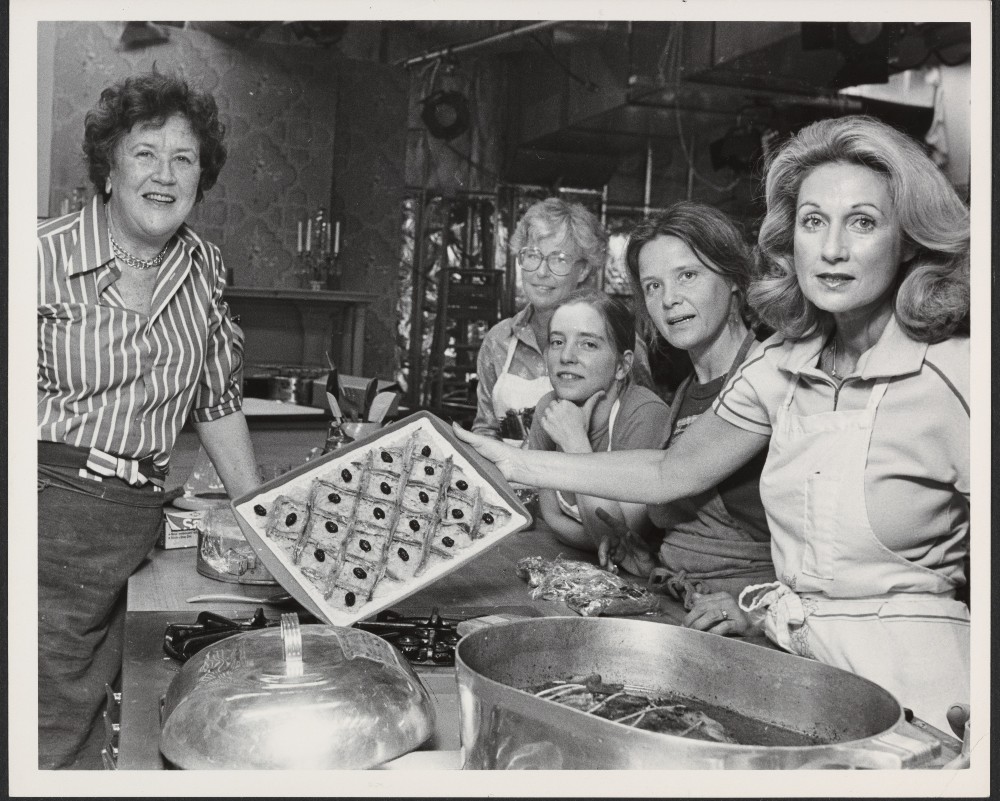
For documentary filmmakers Julie Cohen and Betsy West, it must have been tough to decide what to do as a follow-up to their Oscar-nominated 2018 doc, RBG, about the late Supreme Court Justice Ruth Bader Ginsburg. Eventually, they came upon another great woman who helped define a generation (or two), and that was chef Julia Child, who would become a beloved icon to anyone who ever watched her PBS show, The French Chef.
Long before Emeril and Bobby Flay and Mario Batali, Child was a superstar chef who would be a favored talk show guest throughout the ‘60s, ‘70s, ‘80s, and almost until her death in 2004. Julia beautifully captures that aspect of her life while also exploring her loving relationship with husband, Paul Child, who decided to remain outside the spotlight. Similarly, we get to see the origins of her famous early cookbook, Mastering the Art of French Cooking, co-authored with Simone Beck, with whom Child collaborated throughout the ‘60s before she took off on television.
Julia is every bit as good as RBG and maybe even better due to the amazing work done by Cohen, West and their team, which includes Editor Carla Guttierez, Cinematographers Claudia Raschke and Nanda Fernandez Brédillard, Production Designer Julia Heymans, Oscar-winning Composer Rachel Portman, and many more. All these amazing women played an important role in bringing Julia Child’s amazing life and career into the modern age in a way that makes you feel as if you’re in Child’s home and kitchen with her.
Below the Line got on Zoom with the two filmmakers for the following conversation about Julia.
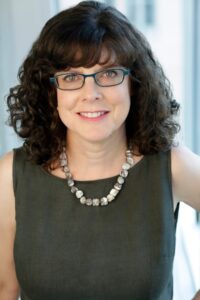
Below the Line: I’ll just go ahead and start with the most obvious first question, and that’s how this came about. Was this something you’d been working on and then brought it to Imagine (the film’s production company) or vice versa?
Julie Cohen: We brought it to them after RBG came out. Needless to say, all kinds of women’s stories came to us, some that we were thinking of, other women that we were considering. We talked to a lot of biographers, including Julia Child biographers, and from a field of stories that we were considering, Julia really jumped out as a story that would be both illuminating, in terms of the way that she changed culture and television and the way we thought about food and the way we thought about women, but also, like a really, really fun film to make. That played a huge role in our decision, and we brought it to Imagine right when their Imagine Docs unit started. I don’t think we’ve said this before, but our pitch to Justin Wilkes… this was our pitch: “Julia Child,” and Justin said, “Yes!” That was the whole bit, and then we all had a drink. [laughter]
BTL: I know there have been quite a few books written about Julia Child, including a few that were cited in the credits for your doc. Where did you find that interview with Julia that you used as narration — was that from an interview?
Betsy West: There are a number of interviews with her. The Television Academy did a long one, and you saw excerpts from the various shows that she appeared on. She was a superstar, people wanted to interview her. So there’s a lot of material from many, many different places that we gathered to kind of create Julia’s voice throughout the film.
BTL: Did you have to binge-watch every single episode of her show and all the appearances she’s done on television to find the best footage to include?
West: Our archive producers definitely binge-watched every single show and categorized everything, categorized moments for us, and we went in and looked at a lot of material. I can’t say that we looked at all several 100 hours that they had, but we looked at a lot of it.
BTL: I especially liked the opening bit with the chickens, since it’s a good introduction to the humor in the movie that was by her nature, but there were a lot of things about her that I’m not sure were very well known. Where did you start? Did you have all this archival material first, or did you start by interviewing people who knew her when she was alive?
Cohen: The first step was going to the Julia Child Foundation, because they sort of partly own almost everything that’s Julia Child-related, including WGBH‘s whole archive of The French Chef. So, that’s not something you can use without them being okay with that. We went to them and explained what we wanted to do. Fortunately, they were fans of the RBG film, so that really helped. We explained, “We really want to tell this story beautifully, but you guys can’t have editorial control.” In fact, that didn’t actually seem to bother them. They didn’t see the film until it was completed, so that worked out great. But yes, start making sure that we had the Julia Child material and archive to work with was step number one.
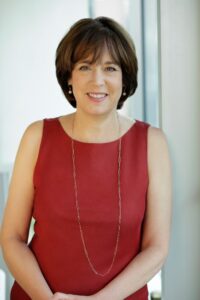
BTL: And that included all the photos and letters and everything was there?
West: Yes, it’s in the archive at Harvard in the Schlesinger Library, and I think that was a great discovery for us. We did not realize what a fabulous photographer Paul Child was.Those photos that he took, especially of Julia and their life in Paris in the 40s and the 50s, are so beautiful and really helped bring the personal story to life, the deeper dive into who was Julia? What made her tick? And that was really important.
BTL: We ran an interview with your editor Carla Guttierez a few weeks back. I didn’t get to talk to her, and I don’t think the interview had seen Julia beforehand. But you also worked with Carla on RBG, so how did you get her started on this one?
Cohen: The way that the timing works out, she was committed to edit this. From the minute that we got a greenlight to do this project, we reached out to her and said, “Will you be the editor?” We had actually done quite a bit of filming and gathering of the archive before she came on board. She probably came on board between six months and a year into the project, but having her be the editor of the film was part of the vision of it, because we all share a sensibility of really wanting to turn this as much into an all-the-feels, immersive, romantic comedy date movie. Yes, it’s a documentary, but we really wanted this to be delicious to watch, and we knew that Carla was gonna share that idea and help it get there.
BTL: One of the big differences between Julia and RBG, of course, is that Ruth Bader Ginsburg was still alive when you made her movie, so you could talk to her and get stories right from her. Since Julia Child has been dead, was it harder to tell her story and figure out its timeline?
West: It’s a different challenge, obviously, to not have Julia there, to do an interview. On the other hand, a lot of other interviews have been done. We really wanted the film to be evocative of her and we didn’t want a lot of experts or talking heads, in that sense. We wanted everybody we interviewed to have a deep connection to Julia. So we were lucky that Julia’s great nephew and Julia’s niece are still here. They were fantastic interviews, and also Julia’s colleagues in the cooking world, from Jacques Pépin and the wonderful Danièle Delpeuch in France and Simone Beck‘s nephew, who knew Julia, who was just so great in describing that wonderful, and sometimes contentious, partnership that Julia had with Simone Beck. We wanted people who really could bring Julia’s personality to life. Anne Willan, also, the chef in England, who had worked extensively with Julia and Julia’s friends in Cambridge — those wonderful Cambridge ladies, who really gave a sense of how Julia came into this world, and kind of rocked it, pretty much. They were all very helpful.
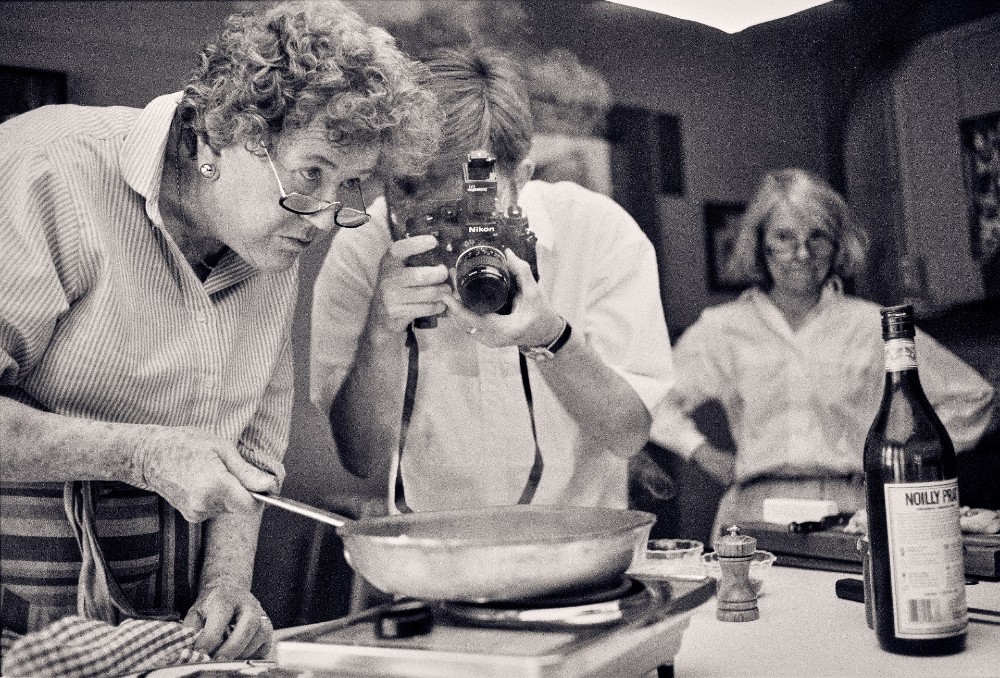
BTL: I also liked how you included Simca (i.e. Simone Beck), who was Julia’s collaborator on her first book, because I feel like she’s someone who may have been forgotten or maybe not even known about in terms of her contribution, because Julia was always front and center.
Cohen: Some of our other interview subjects talked about her a bit in the interviews for the film. We really wanted to focus on her nephew, who was such an amusing character, in his own right, and who was not putting a halo on his aunt. He says, “This was a difficult woman,” and as Ann Willan pointed out, so was Julia. You had some real strong, bristly, sometimes head-butting personalities, but there’s no reason to shy away from those sides of the story, even when you’re doing a portrait that is loving. We do think of our films being loving towards Julia, but the fact that we love that scene of the two of them in the early 70s in the house in France, baking a spinach pie where you can just feel the tension between them. And Julia’s like, “Maybe we can use a pie mix,” and Simca’s like, “I am French. I do not use a mix.”
BTL: What I love about the doc is that you really feel as if you are there as Julia’s story is unfolding, to the point where you can almost smell the food coming from the screen. I’m not sure if you used the same cinematographer for the food as you did the rest of the film but that food did look quite delicious.
West: I’m really glad that you mentioned the food. That food shooting was first and foremost. Our main photographer, Claudia Raschke, with whom we’ve worked on a number of films, shot the food in New York on a set that our producer Holly Siegel envisioned and had created to match Julia’s kitchen. We picked classic Julia recipes with the help of our food stylist Susan Spungen, to really illustrate the various points that we were going to be making. But we had an additional photographer in France, Nanda Brèdillard, who is a specialist in macro-shooting. When we first saw his footage, there’s like this thing we’re looking at, it looks like a mountain, and then, it pulls out a little bit, and you realize, “Oh, that’s a mushroom!” So he did some of the slow-mo, specialized shooting, and then, the brilliant, Carla managed to edit these two things together, so in a number of the sequences, there actually is footage from New York and from Paris of the same dish being cooked in different places that’s edited together. The whole idea, and I think Claudia has said this, “Food is emotional. Let’s try to get at the emotion of creating beautiful food.” I think she did a great job.
BTL: How do you negotiate who got to eat the food after you’re done shooting? Did you have to split it into 100 pieces, so everyone gets a little bit?
Cohen: No, it actually wasn’t a problem, because in order to have enough food to shoot it properly — well, none of us were in France, because this was in the COVID thing, so I don’t know who ate the food in Paris — but from the New York food, in order to have enough, you actually need to have a number of versions of each dish at various stages of preparation, to make the shooting more efficient. The plus side of that is, by the end, there’s like a lot of Beouf Bourgignon, so with enough Tupperware, which there was, it was divided up. Everyone on the set got to take home what they wanted and eat it, and I had a whole giant Ziploc bag that was just full of the pears in that red wine poaching glaze, which my husband and I ate with ice cream for like a week. It was fantastic.
BTL: I was actually amazed by how well you replicated Julia’s kitchen on a set with all the pots and pans and how they were laid out. That must have taken a lot of great effort to find just the right things.
Cohen: That was really a major project for Holly Siegel, our producer, who worked with a set designer to figure out how she was going to create something three walls of which looked like Julia’s kitchen, but that you could shoot from all different angles. There were like walls that pulled away, so that a camera could come through in the other direction. And then on top of that, to get the famous Julia pegboard [on which] all of the pots and pans hung, that has little drawings of each pot and pan so you know where it fits. She managed to figure out, either the exact pot and pan or a close facsimile of every single one, and they’re getting them off of eBay and whatever. When we were still working in the officer before the COVID shutdown, our AP and production assistant were basically buried underneath a pile of copper pots, as this stuff would all come in.
BTL: Obviously, a lot is done to make some of the best docs, but that kind of has to be above and beyond to do all that.
West: It was a labor of love for Holly, really. She got such a kick out of it. I can’t tell you how much attention to the detail… I mean, she found an old abandoned Garland stove in a garage in New Jersey and had it renovated so that the stovetop was working, and that was shipped into New York. I mean, she really put a lot of care into this, and it made the shoot special.
BTL: You mention COVID and all this food, so maybe this wasn’t the best movie to be making in a pandemic, since so many people weren’t able to go out and have nice food inside a nice restaurant for so long.
West: Actually, it was a great movie to be made during COVID, in a way, because we were all in our home kitchens. We’re all cooking now, all the time. You’re not going out to restaurants. In my case, I was going to the local farmers market outside, and it just seemed sort of appropriate and helpful to be looking at how Julia approached cooking and then going into my own kitchen, even though I don’t claim to have replicated all of Julia’s recipes, but certainly, it was an inspiration, and I think [it] made us appreciate making food and eating it together with the people that you love.
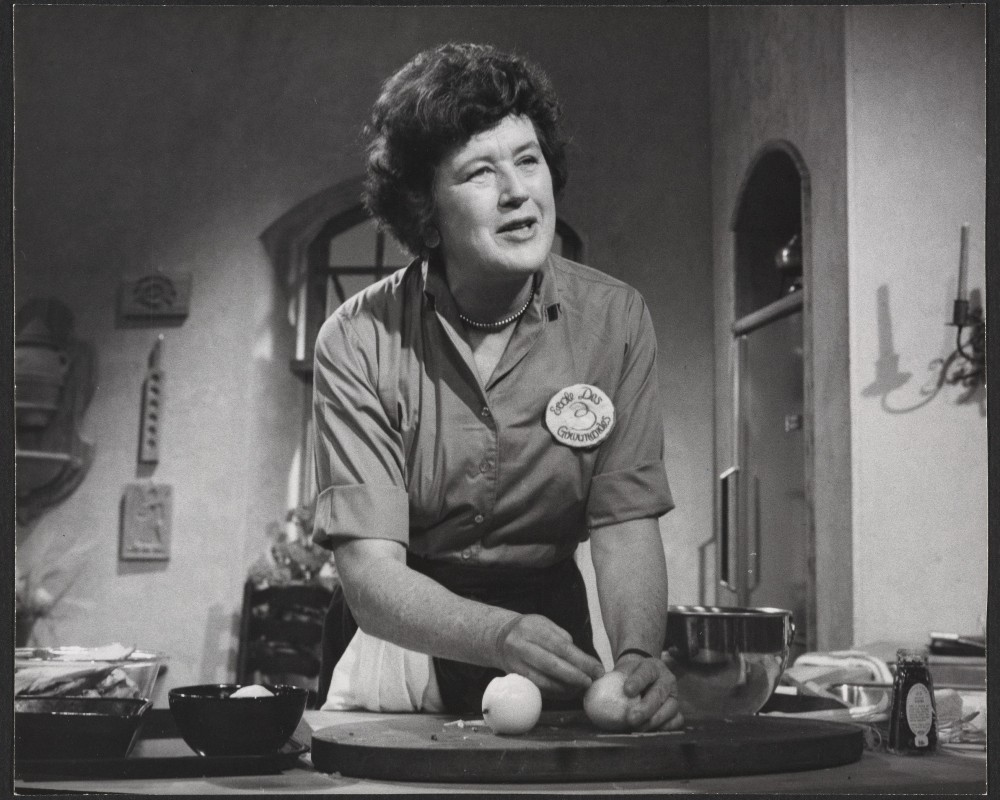
BTL: I also want to mention Rachel Portman’s music, because obviously adds a lovely touch along with the letters and the loving comments people make about Julia and her food. But Rachel’s music is quite beautiful, so how did you come to her to do the score and at what point did she get involved? Did you already have a first edit or rough cut?
Cohen: Yes, we already had pretty much a fine cut by the time Rachel actually looked at the film, although she had agreed to come on board much earlier than that. We very much wanted to bring in someone who specialized in feature narrative film composing to create that feeling of [being] at a romantic movie. Yes, it’s a doc, and it’s all the real people, but we wanted this to feel like a sweeping romantic comedy. We thought Rachel’s music would be perfect for that, which it was. When you talk about emotion, she has a really interesting way of working where the spotting session was basically her going through every minute of this film, after she had seen it, and making Betsy and I just shout out the emotions that we were trying to convey. It felt like an odd process. We were like, “Enlightened!” “Determined!” “Frustrated!”… and it took three hours. We’re like, “What was that?” And then she came back with all the cues, and they were almost all perfect from the start. She’s amazing.
West: It was an amazing way of working. I mean, she didn’t start early on, and as Julie said, the film was kind of there, and wow, did she just bring it to life with that music! It was so beautiful.
BTL: What Julie described sounds more like a therapy session.
Cohen: At the time, we were like, “What was that? What did we just do?” And then the music came back, and it totally worked.
BTL: You obviously made this entire movie during the COVID times…
West: We started it before. We did a lot of shooting in the summer and the fall before COVID, and we spent a week in France in the beginning of October of 2019, which, in retrospect, it was just pretty glorious to be going to all Julia’s haunts in Paris, and to have watched the filet of sole being cooked in the restaurant where she first landed in Rouen. I mean, the whole thing was very cool, and then, we came back and started the edit and then COVID hit.
BTL: So most of the post was done during COVID then?
West: Yes, and the other difficulty, of course, was with the archive, because the archive houses shut down, so that was a challenge in working to get the archive. As Julie said, the food cooking that she just described, that was done during COVID, so everybody was masked and we had all kinds of safety precautions. That was a challenge, which we did in July of last summer in a kind of lull, but with a LOT of safety precautions.
Julia will play theatrically in New York and Los Angeles starting Friday, November 12, and presumably, it will expand to other cities after that.
All photos courtesy Sony Pictures Classics, except where noted.

